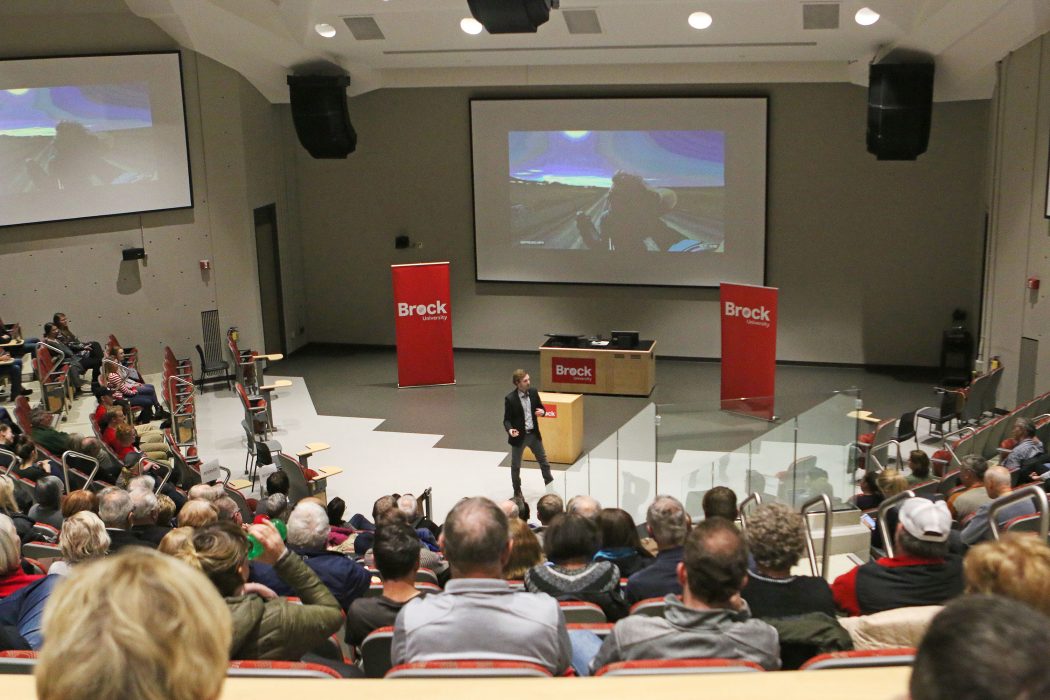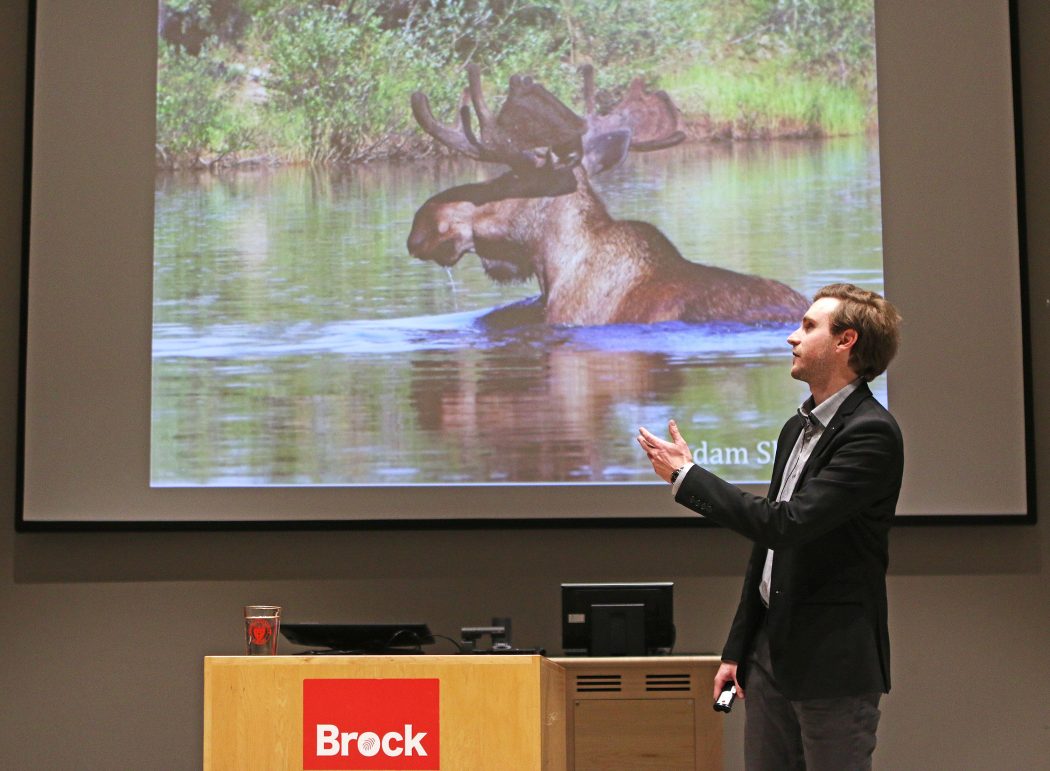 Brock History graduate and modern-day adventurer Adam Shoalts spoke about his latest expedition during a talk at the University Dec. 7.
Brock History graduate and modern-day adventurer Adam Shoalts spoke about his latest expedition during a talk at the University Dec. 7.It was an abrupt awakening that sent chills down Adam Shoalts’ spine.
The Brock University History grad and modern-day voyageur heard the aggressive snort just outside his tiny nylon tent — the sound shattering the usual quiet of an evening in the remote Canadian Arctic.
Shoalts (BA ’09) peered out through the structure’s zipper only to find a massive muskox staring back from only a few feet away.
“I started to get a little worried,” said the 31-year-old Pelham native, as he recalled the intimidating experience in front of a crowd of more than 300 people in Brock’s Sean O’Sullivan Theatre.

More than 300 people gathered in Sean O’Sullivan Theatre on Dec. 7 to listen to Brock grad and modern-day adventurer Adam Shoalts speak about his latest expedition.
He strapped on his life jacket for protection and prepared for impact, should the enormous animal decide to charge, but after 10 tense minutes the creature retreated back into the wild.
“The muskoxen was the only animal on the journey that gave me a fright,” Shoalts said while sharing with the crowd tales from his amazing one-man expedition this summer that saw him walk and canoe 4,000 kilometres across the Yukon, Northwest Territories and Nunavut.
Stories of wildlife, treacherous terrains and sleepless nights were among those featured during Alone Across Canada’s Arctic, a public talk and book signing held at the University Dec. 7.
Shoalts set off to conquer Canada’s wild in May, knowing it would be a race against time to reach the finish line by September. During every twist and turn, he could feel Mother Nature breathing down his neck, threatening to usher in winter without warning.
But with determination on his side, he completed the marathon, done in honour of Canada’s 150th birthday, slightly ahead of schedule on Sept. 6.
“Through the whole journey, I just kept telling myself, ‘Winter is coming. Winter is coming,” he said. “Winter can set in as early as mid-August, putting things to a halt. I knew I just had to keep going.”
With the clock ticking down each day, Shoalts felt the pressure to keep pushing forward.
“I was like a drill sergeant inside my own head, saying, ‘Keep going. You don’t need to rest’.
“On normal expeditions if I woke up to rain pounding on my tent and high wind gusts, I would wait it out and hunker down. There’s no point in getting drenched to the bone. But on this expedition I didn’t do that at all. I’d just screw up my courage, put on my boots and head out in the wet weather, because tomorrow could be worse.”
Knowing that the next day might bring a snowstorm or unbearable winds helped keep the young adventurer going, often putting in a 15-hour day that began in the early morning hours.
One of his biggest challenges was dealing with ice floes that made it dangerous to navigate the waterways on his route, causing delays. Some days the abundance of ice left him stranded on shore, while others, he was able to break through blockages to slowly continue his journey.
But ice wasn’t the only obstacle the Arctic threw his way.

Brock History graduate and modern-day adventurer Adam Shoalts spoke about his latest expedition during a talk at the University Dec. 7.
Some days the wind was so fierce that it was impossible for him to canoe at all.
“I would be trying to canoe down current, but because the wind was going in the opposite direction, it was almost reversing the flow. I would try to paddle but end up spinning like a corkscrew, 360 degrees.”
Rather than quit, Shoalts often strapped on his waders, got into the water and dragged the canoe behind him.
It meant going at a significantly slower pace, but he found comfort knowing that at least some progress was being made. During the expedition he did this mode of travel on foot through water for hundreds of kilometres, leaving his waders torn to shreds.
When the water became too dangerous, Shoalts — and his gear — was forced back on land.
Doing a portage took multiple trips back and forth — one with his canoe, two with barrels of supplies, and a fourth with his backpack. Four kilometres of progress required nearly 30 kilometres of walking.
“All that said, my progress was much faster than I ever dared to hope,” Shoalts said. “You have to hope for the best but plan for the worst, because anything can happen.”
While travelling over rocks and mushy tundra could be exhausting, the most treacherous and psychologically taxing stretches came on the icy water. There were many “white-knuckle moments” during his crossing of Great Bear Lake, for example, which took about two weeks and 430 kilometres to complete.
“I’m in this huge lake, the eighth largest in the world, in a 15-foot canoe that’s not meant for open water of that size. There was a lot of ice to complicate things, strong winds to paddle against and the water was very cold.
“There were times I was paddling for 15 hours consecutively without a break because I was afraid I wouldn’t have another calm stretch (of weather). I had to take advantage of it.”
It meant throwing any regular sleep cycle out the window and immediately hitting the water the moment the lake calmed. Of course, this was made a little easier by the Arctic’s near 24-hours of daylight that lasted for the first three months of his journey.
“I could go out at any hour of the day,” he said, “and often I did.”
When August arrived and nights got longer, Shoalts was stunned by a sight that had once been so commonplace.
“I remember when I saw my first star on the expedition. It looked like a really shiny diamond in the sky. I hadn’t seen a star for three months. It was so incredible. I’ll never take it for granted again.”
Isolated but not alone, Shoalts often found himself surrounded by wildlife.
In addition to his close encounter with a territorial muskox, he encountered several grizzly bears and shared a moment with a family of Arctic wolves, the young pups trotting and jumping along the banks of a river as Shoalts paddled his canoe just offshore.
“When you look a wild wolf in the eye and it looks right back, it’s almost an indescribable feeling,” he said. “It’s really special to see such a magnificent animal in its natural habitat.”
Now that he has safely returned to the comfort of home, Shoalts is busy sharing details of his adventures and Canada’s history at a variety of speaking engagements, including the special Brock presentation.
“It means a lot to me to be able to give back to the Brock community and to encourage students to chase their dreams,” said the History grad. “I hope I can inspire students to push the boundaries and make their own path.”
Brock University was a co-sponsor of Shoalts’ exhibition, contributing lightweight, quick-dry outerwear to help during his excursion through forest, muskeg and tundra.
He released a new book in October, A History of Canada in Ten Maps: Epic Stories of Charting a Mysterious Land, and plans to write about his latest adventures in the near future.
While he has no lengthy expeditions planned for 2018, Shoalts, a Royal Canadian Geographical Society Fellow, will be joining the organization on a two-week journey in Antarctica this winter.

Brock History graduate and modern-day adventurer Adam Shoalts spoke about his latest expedition during a talk and book signing at the University Dec. 7.









